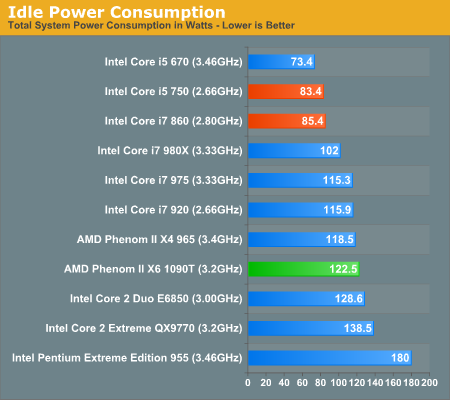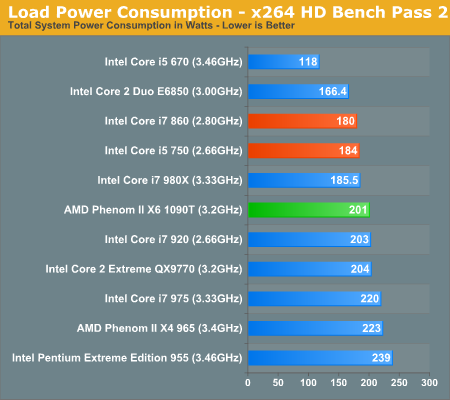AMD's Six-Core Phenom II X6 1090T & 1055T Reviewed
by Anand Lal Shimpi on April 27, 2010 12:26 AM EST- Posted in
- CPUs
- AMD
- Phenom II X6
Power Consumption
Most impressive is AMD's ability to run six 45nm cores at the same power consumption as four 45nm cores. The Phenom II architecture in general does reasonably well at idle, but without power gating AMD can't compete with Intel's idle power levels.
Under load Intel also has the clear advantage.












168 Comments
View All Comments
Eeqmcsq - Tuesday, April 27, 2010 - link
Hey, found a typo, on the AMD Turbo page:"While mainstream CPUs are down at 65nm". I think you meant 65w.
Anand Lal Shimpi - Tuesday, April 27, 2010 - link
Thank you! Fixed!falc0ne - Thursday, April 29, 2010 - link
:O) lolRick83 - Tuesday, April 27, 2010 - link
there's also an "i7 670" in one of the charts on the first pages, which should clearly be an i5.msc_chandu - Tuesday, September 7, 2010 - link
nm refers to nano-meter and 65nm is a technology node. So, the processor manufacturing has been rolling down. For example, 250nm to 130nm to 90nm to 65nm to 55nm etc...It is not a typo and was mentioned correctly. :)
DaCentaur - Wednesday, September 15, 2010 - link
Chandu naanna, if you take a look at the context, i.e. the sentences before and after the "wrong" sentence, you should be able to understand why it should be "W" instead of "nm"."High end desktop CPUs now spend their days bumping up against 125 - 140W limits. While mainstream CPUs are down at 65W. Mobile CPUs are generally below 35W. These TDP limits become a problem as you scale up clock speed or core count."
Ardhamainada? :D
creathir - Tuesday, April 27, 2010 - link
As usual Anand, the article was great and really helped with figuring out where I am taking my wife's next computer. I was tempted to go AMD this time around for her next PC, but after reading this I believe I will stick with an Intel solution. Thanks man!- Creathir
webmastir - Tuesday, April 27, 2010 - link
yup. agree...very informative article. thanks!pow123 - Wednesday, May 5, 2010 - link
You would have to be insane to pay $1000 for a chip that may be good for gaming. at $199 with slightly lower performance its a no brainer. When I build a system, I don't care if the frame rates etc is 10 to 15% better. Who cares ; the chip is fast and I have not problems playing high end games. I have no special setup and it does everything that my friends I7 can do. Good for me I get more pc for the buck . Go ahead and go broke buying just a motherboard and cpu when I can get a modern motherboard a cpu, 6gigs of ddr3 1600, a 1tb hd and a dvdrw. More for me.abd-jbr - Friday, June 18, 2010 - link
i compared intel and AMD from almost AMD start ( K6 II ) CPU , i believe that AMD did not change their Policy much : they still offer more for less , with one different , in that time the market was also different from today , now a days , you can easly found all the hardware you need and it's compatible and works with AMD ,it's accurate Say : it's not about absolute Perf , it's about pref at a given price
and in this , i think AMD wins .